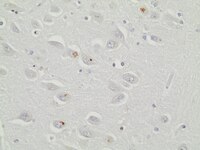The C9orf72 GGGGCC repeat is translated into aggregating dipeptide-repeat proteins in FTLD/ALS.
Mori, K; Weng, SM; Arzberger, T; May, S; Rentzsch, K; Kremmer, E; Schmid, B; Kretzschmar, HA; Cruts, M; Van Broeckhoven, C; Haass, C; Edbauer, D
Science (New York, N.Y.)
339
1335-8
2013
Afficher le résumé
Expansion of a GGGGCC hexanucleotide repeat upstream of the C9orf72 coding region is the most common cause of familial frontotemporal lobar degeneration and amyotrophic lateral sclerosis (FTLD/ALS), but the pathomechanisms involved are unknown. As in other FTLD/ALS variants, characteristic intracellular inclusions of misfolded proteins define C9orf72 pathology, but the core proteins of the majority of inclusions are still unknown. Here, we found that most of these characteristic inclusions contain poly-(Gly-Ala) and, to a lesser extent, poly-(Gly-Pro) and poly-(Gly-Arg) dipeptide-repeat proteins presumably generated by non-ATG-initiated translation from the expanded GGGGCC repeat in three reading frames. These findings directly link the FTLD/ALS-associated genetic mutation to the predominant pathology in patients with C9orf72 hexanucleotide expansion. | Immunohistochemistry (Paraffin) | Human | 23393093
 |










